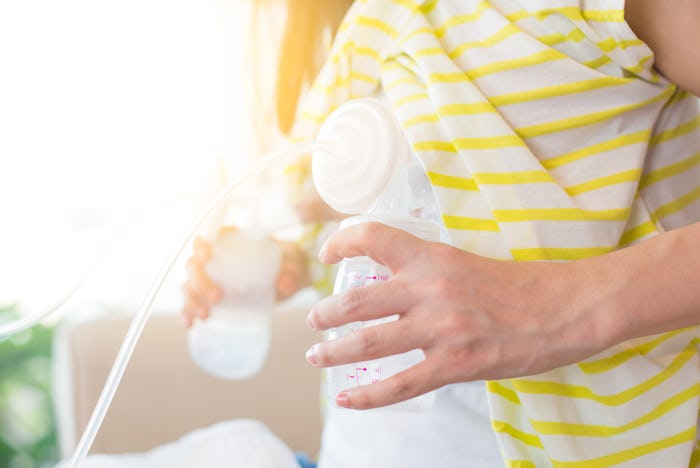Life

Everything You Need To Know About Choosing A Breast Pump To Induce Labor
You've likely heard before that nipple stimulation causes contractions. In fact, it's so effective, it's considered a natural method for inducing labor. If you're postdates and have the all-clear from your OB-GYN, you might want to invest in a breast pump to really get the party started. But what kind of breast pump is best for inducing labor?
Breast pumps come in two kinds. A manual breast pump is hand-operated, so be advised that if you pump often, your wrist will get a workout. (I have a friend who sprained hers.) Or you can opt for an electric pump, which comes in a single or double variety. However, you don't actually need a breast pump to induce labor, because it's nipple stimulation — more than the act of pumping — that produces the hormone oxytocin, which in turn creates contractions, according to the American Pregnancy Association. Manual pumps, electric pumps, oral stimulation, or tweaking with your fingers can all stimulate your nipples effectively enough to cause contractions, noted Trimester talk. That said, an electric pump may mean less work for you — especially if you're suffering from annoying pregnancy carpal tunnel.
According to Monica Lee, MD, a mom of one son and an OB-GYN in the LA metro area with Mommy MD Guides, nipple stimulation works so well that doctors used to induce labor with nipple clamps in lieu of Pitocin (way back in the day, that is). Healthline also reported on a fascinating Turkish study in which 390 women were separated into three groups: those who'd try to induce through nipple stimulation, uterine stimulation, and a control group. Amazingly, the women using nipple stimulation experienced the shortest labors.
Doctors and healthcare providers have known about induction via breast pump for a long time. In fact, a 1986 study published in The Journal of Reproductive Medicine showed that electric breast pumps stimulate uterine contractions more quickly than infusions of oxytocin, which is incredible if you think about it. While electric pumps are extremely powerful, they can also cause pain, especially on high settings, so be careful with yours. Most sites recommend covering your breast with a warm cloth for five minutes before you begin, and pumping no longer than 15 minutes on each side. When you feel a contraction, pause to let it pass before beginning again.
While any type of nipple stimulation will do, if I were trying to induce today, I'd choose an electric pump primarily because of its multiple settings (you may need to figure out what's right for your body) and the fact that I know my hands get tired using the manual ones. Which brand of pump you choose doesn't matter so much, but it should be something you like and plan to use later — those pumps are expensive, after all. Read reviews, ask your friends, you know the drill.
Also, be sure to clear your home induction with doctor first. I can't stress this enough. They may ask you not to proceed if you have any health concerns, and you should never attempt a natural induction if you're under 40 weeks gestation. EHow Health also recommended letting your doctor, midwife, or doula know that you're going to use the pump — in rare cases, nipple stimulation can cause a uterus to contract too intensely, and you certainly don't want to get caught in a dangerous situation without healthcare providers near at hand. Let them know your plans so you can all be prepared for what happens.